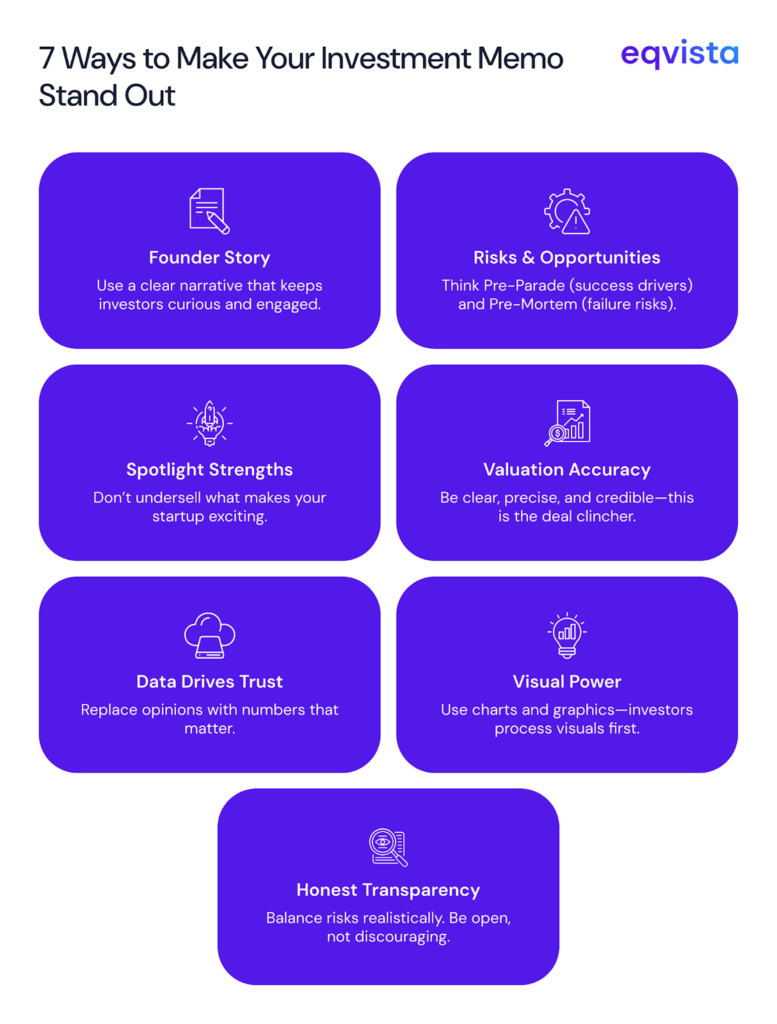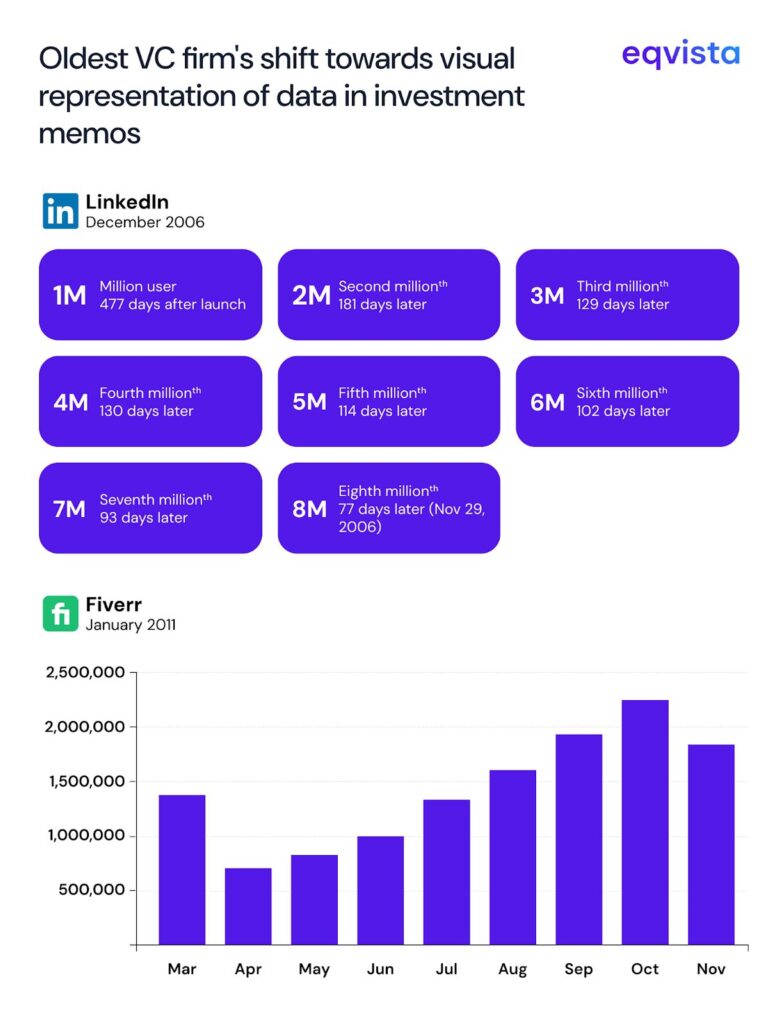How Can I Make My Investment Memo More Convincing for Early-Stage Investors?
US startups raised over $174 billion in more than 4,000 funding rounds in 2025 until the month of August. In the same period last year, the number of funding rounds was over 7,000. Due to the extremely high volume of funding deals, you cannot expect venture capital investors to spend more than 15-25 minutes on your investment memo.
That’s why we’ve compiled seven strategies that can help you craft a concise yet engaging and impactful investment memo.

7 strategies to make your early-stage investment memo more compelling
You will stand the best chance to secure funds from early-stage investors if you apply the following 7 strategies while crafting your investment memo:

Construct a Compelling Founder Story
There are some elements, such as financial projections, solution, market size, competition, and team, that are expected in investment memos. But you can take certain liberties with the layout and structure to make the investment memo more engaging.
You can also optimize the text itself to make it more engaging with a simple narrative tool.
In speeches, hypophora is a powerful tool for controlling the narrative and shaping the thought patterns of the audience. Here, the speaker asks a question and then immediately answers it to improve the impact of the solution they are presenting.
In investment memos, you should try to achieve implied hypophora or curiosity gap framing. Instead of directly asking questions, you should present data and context so that each section naturally answers the questions sparked by the previous one.
When done skillfully, this creates such a seamless narrative that the reader finishes the memo feeling that every concern about the opportunity has been addressed.
Re-Imagine the Threats and Opportunities Section
At the early stage, a startup’s success is often largely dependent on whether the market conditions are conducive or not. But it is very easy to write a bland summary of external factors, such as industry and economic conditions, that everyone is already aware of and doesn’t need to read.
Elena Mazhuha of Flyer One Ventures has an interesting approach to drafting this vital yet often check-the-box exercise section of the document. She suggests including a section that she calls the pre-parade and pre-mortem. Here, you should outline the factors that can drive a startup toward success (its ‘parade’) and those that may result in its failure (its ‘mortem’ or death).
This approach will help you focus on the external factors that are most directly connected to the startup’s success. As a result, you would end up writing an engaging and concise version of an otherwise tedious section.
Highlight the Strengths
You may end up underplaying the strengths, advantages, and market opportunities because of your own risk-averse mindset. You may confuse this as being transparent, but you must note that there is an entire section in the investment memo to describe the risks. In that section, you should transparently discuss risks and threats in detail. But when you talk about things that make you excited about the opportunity, you should try to build momentum towards the final call-to-action, without going overboard.
Ensure Accuracy in Valuation Projections
In any investment deal, the real clincher is always going to be the valuation projections. While other elements, such as storytelling, conciseness, and transparency, do matter, investors often skip to the valuation projections to decide if they want to read the entire investment memo.
This added emphasis means that there is little to no room for inaccuracies and exaggerations.
In a straightforward and easy-to-read manner, you must present the valuation projections. Then, you simply need to substantiate your compliance with accurate valuation insights. This is an area where the insights from a credible valuation expert, like Eqvista, can go a long way.
Data Trumps Opinions
Even the most valid investment rationale will be thrown out by investors as fabrication or fantasy if it’s not backed by data. Investors do not entertain funds that hide behind the lack of financial data in private equity to present subjective opinions in investment memos.
Over the last few decades, data about market conditions and consumer behavior have become increasingly accessible. The only limitation that still persists is the lack of financial data, which inhibits competitor comparisons based on financial performance. But in all other areas, data can be used to add weight to your arguments.
That being said, you do not need to forcefully insert data points into every sentence. That will only overwhelm the readers. Instead, you should tactically present data points and help the reader connect the dots.
Everyone Is a Visual Learner In 2025
With dwindling attention spans, the importance of leveraging intuitive charts to explain complex data trends and concepts has only increased.
Observe how these investment memos, created about 4 years apart by the same venture capital firm, present trends in user growth:

At first glance, Fiverr’s growth looks more impressive. Before the reader even checks the title or axes details, they can visualize the steady growth in traction.
However, if we look closer, we can see that LinkedIn’s user base has been growing exponentially. Furthermore, the chart for Fiverr tracks monthly visits, which may not always be from users. Some of these visits would be from people who just want information about the platform. But in the LinkedIn memo, the fund is presenting user growth. These are people who have found enough value in LinkedIn to go through the hassle of creating an account and are likely to visit frequently.
This shows how convincing data can become with the right visualization.
Fortunately, creating high-quality charts and graphs has become more accessible with AI tools.
Transparency Builds Trust
Once an investor is interested in the opportunity you are presenting, at some point while reading the memo, they will ask, ‘Ok, but what’s the catch?’
Every investor knows the reality of venture capital. 90% of startups fail, and more than 2/3rd of the startups do not provide a positive return to investors. So, do not try to downplay the risks of the investment opportunity you are presenting. You must ensure that, after reading the memo, the investor has a similar understanding of the risks as you.
At the same time, you must avoid the other extreme as well. While transparency is important, presenting the risks too grimly will only scare away the investors, which defeats the purpose of preparing the investment memo.
Eqvista – Democratizing Actionable Valuation Insights!
The key to a convincing investment memo that springs investors into action lies in storytelling, accessibility, and transparency. Without good storytelling, the onus will be on the investors to discover what makes the opportunity enticing. By accessibility, we mean how easily someone with limited time on their hands can absorb all the key information. Without transparency, investors will be apprehensive and back out in fear of hidden risks.
Eqvista’s data-backed valuation reports equip you with a compelling, evidence-based narrative that strengthens your investment memo and maximizes your appeal to potential investors. Contact us to get a quote for an investment valuation!
